|
|
 |
|
|
|
|
|
|
|
|
Recently in History CategoryPhotos of the Shrine in 1985
By on July 23, 2011
Call for donations for the Time Capsule
By on April 3, 2011
To mark the end of the restoration, a Time Capsule will be sealed inside the Stoneham War Shrine in May 2011, with a set duration of 93 years and a scheduled final opening date in 2104. The Capsule will contain elements of local history and community memory, and will be a record of the area's identity, with items that reflect the spirit of North Stoneham, past and present. Such items might include handwritten memories, ephemera, photographs, drawings, letters to the future, and small objects ... Can you contribute? Book of Remembrance
By on May 29, 2010
The Book of Remembrance is now open, with a detailed entry for each of the thirty-six men commemorated at the Stoneham War Shrine. We hope, eventually, to find images of every one of the men for inclusion on the Faces of the Fallen page. If you can provide any information about, or photographs of, the men, please contact us.
New free printed guide
By on March 5, 2010
The guide has now been reprinted, and includes new information and photographs. To receive a free copy, use the online form.
Design sketch by Christopher Hatton Turnor
By on February 1, 2010
New information suggests that the original design sketch of the Shrines is by the architect and social reformer Christopher Hatton Turnor (1873-1940). The handwriting and style of the Shrine sketch (below) seems to match other drawings by Turnor (second below). 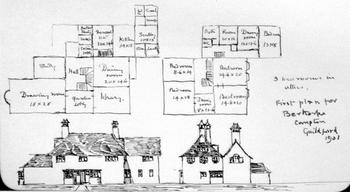 The design of the Shrine roof in the sketch closely resembles that of a lych gate (below) at Stackpole, Pembrokeshire, which was designed by Turnor. 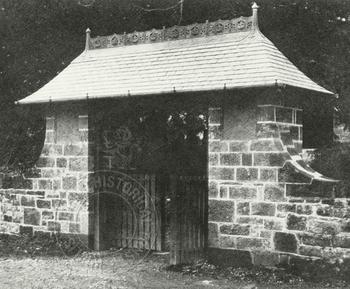 After leaving Oxford University, Turnor initially worked as an architect, firstly for Edwin Lutyens - with whom he designed the Ferry Inn at Rosneath for Princess Louise - and later for the Arts & Crafts architect Robert Weir Schultz (1860-1951). Turnor's most famous independent work is the Watts Gallery in Surrey (which came second in the BBC Restoration programme in 2006). Turnor was an early enthusiast for cement as a building material. He was also a skilled craftsman, designing furniture and interior fittings. Turnor had apparently stopped practicing as an architect by the outbreak of the First World War. Christopher Turnor - known as Kit - was a close friend of Charles Phillimore, Violet Willis Fleming's brother, and carried out architectural work for the Phillimore family at Shedfield in Hampshire. A director of Coutts Bank, Charles Phillimore was in charge of the Willis Fleming family's finances during the early twentieth century, when the Shrines were built. In 1903, Turnor inherited his family's estates in Lincolnshire, and became increasingly interested in estate management and agricultural reform. He published several books on these subjects, for which he is best known. Turnor remained friends with Lutyens, who with Gertrude Jekyll was a frequent visitor to Turnor's mansion at Stoke Rochford in Lincolnshire. Turnor's first diary, which he kept from October 1917, however shows that he had nothing to with the physical construction of the Shrines from that date. During the War, he served on numerous Government committees. Stoneham Lintel Carvings
By on January 29, 2010
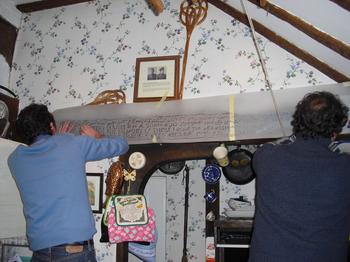 Last Tuesday (26th January) the surviving sections of carved lintel from the Stoneham shrine were inspected by the wood carver, carpenter and architects, prior to the production of replicas. Subtle variations from that of the Havenstreet Shrine were discovered in the wording of the central text. Rubbings and photographs were taken to accurately record its size and spacing.
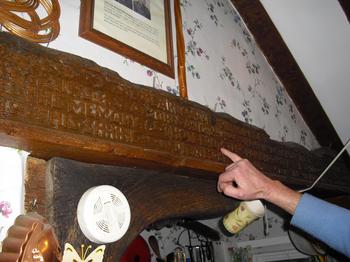 Dick's Diary
By on December 30, 2009
The wartime diaries of 2nd Lieut. Richard Willis Fleming (1896-1916) are being transcribed, and, beginning on 24 February 2010, the entries will be published daily as a weblog - Dick's Diary - 94 years to the day since they were first written. The diaries start on 24 February 1916 and follow the 162 days until Richard's death in Egypt on 4 August.
Havenstreet War Shrine Listed
By on November 10, 2009
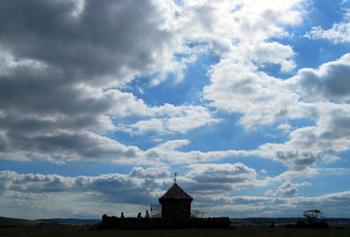 Coinciding with Armistice Day, English Heritage have listed the Stoneham War Shrine's twin at Havenstreet, giving it Grade II status. It is one of 18 war memorials being listed or upgraded by English Heritage at this time. See www.guardian.co.uk. Coinciding with Armistice Day, English Heritage have listed the Stoneham War Shrine's twin at Havenstreet, giving it Grade II status. It is one of 18 war memorials being listed or upgraded by English Heritage at this time. See www.guardian.co.uk.Frederick Rowe's Death Penny
By on August 23, 2009
We recently received a mysterious parcel, which turned out to contain a 'Death Penny' for Frederick George Rowe, one of the 36 men commemorated at the Shrine.
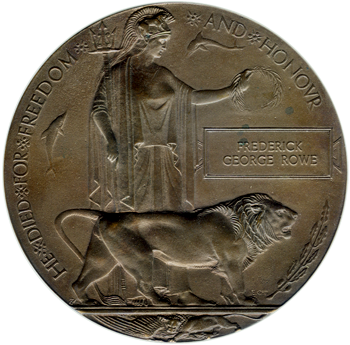 Private Rowe served with the Hampshire Regiment, and was killed in action in the Balkans on 2 September 1918, aged 31. He was born and brought up at Bassett Green, the son of Emmanuel and Eliza Rowe. Frederick left a widow. A Death Penny (or Widows' Penny) was given to the next of kin of every serviceman killed in the Great War. We have so far been unable to trace any relatives of Frederick Rowe. The penny is the kind gift of Alan Rentell. 'Shrines built while the First World War went on'
By on June 20, 2009
'Flower-strewn memorials were part of British life long before the death of Diana, Princess of Wales', writes Christopher Howse in the Telegraph.
|